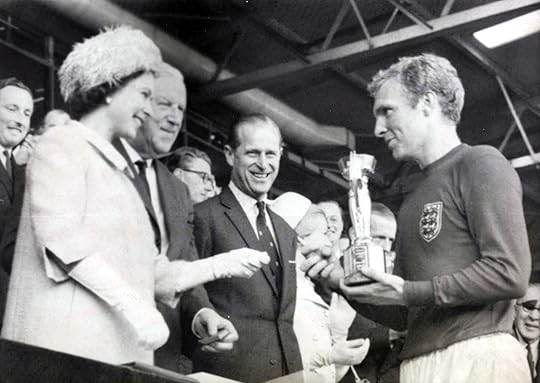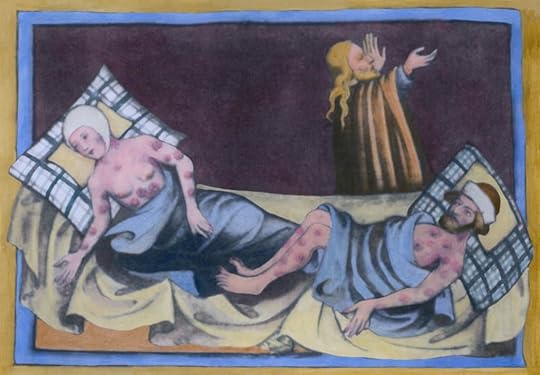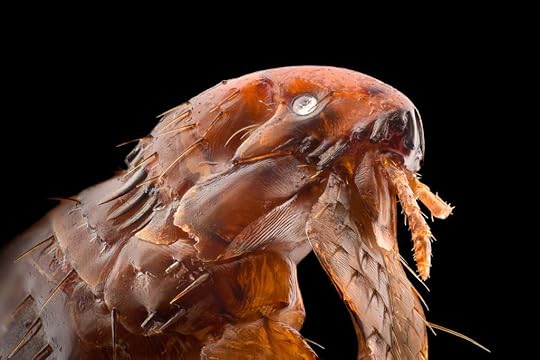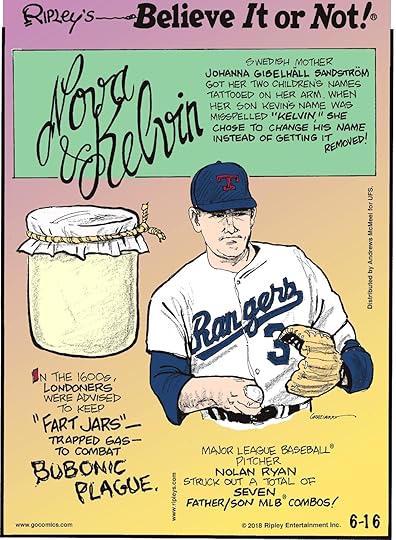Ripley Entertainment Inc.'s Blog, page 337
June 18, 2018
CARTOON 06-18-2018
June 17, 2018
CARTOON 06-17-2018
June 16, 2018
CARTOON 06-16-2018
June 15, 2018
Russians Receive Smile Training For World Cup
Featured in Ripley's Believe It or Not!

[June 10-16th, 2018] A gator holds up a plane in Florida, the bubonic plague surfaces in Idaho, and Russians receive smile training so they can greet guests during the World Cup.
Why Did the Gator Cross The Road?
Florida is known for its abundance of alligators, but the predator has become so active in the summer heat that they’re causing traffic delays even for planes. At Orlando International Airport, one pilot had to wait for an alligator to finish crossing the runway taking off.
“Believe it or not there is a gator on the runway and we are waiting for it to cross.”—Spirit Airline pilot
Plague Resurfaces In Idaho
The first human case of the Bubonic plague in 20 years has surfaced in Idaho. The disease can still prove fatal, according to the W.H.O., but medical attention was provided fast enough for the child affected to recover. How the boy contracted the disease is still under speculation. This incident comes shortly after new studies found that the plague didn’t spread through rodents during the Black Death, as was previously thought.

A 270 Page Sentence
Author Mike McCormack’s new book, Solar Bones, is 270 pages long but is only about the thoughts of one man sitting at his kitchen table in Ireland. Believe it or not, the book contains only a single sentence. Although McCormack’s novel makes use of stream of consciousness and uses minimal punctuation, it has won him literary prizes, including one worth 100,000 euros!

Britain Crowns “Sexiest Cow”
A doe-eyed Jersey cow named Char has been declared the sexiest cow in England. The contest—which pitted 39 cows against each other—was decided by RAGT, a company that makes animal feed. Judges fell in love with Char’s lashes and glamorous expression, almost unanimously declaring her the winner.
We’re thrilled to announce the winner of Britain’s Sexiest Cow as Char, a jersey cow owned by @CharCunningham & our runner-ups Tetford Twinkle & Bonnie!
That Time A Pooch Named Pickles Found The Stolen World Cup Trophy…
Featured in Ripley's Believe It or Not!

Over 50 years ago, a dog helped solve a high-profile crime after a pair of thieves stole the World Cup trophy, known as the Jules Rimet trophy, during its public exhibition at the Methodist Central Hall in Westminster.

Jules Rimet M.I.A.
London gangster Sidney Cugullere and his brother Reg swiped the prize on March 20, 1966, just four months before the FIFA World Cup was set to take place in England. The Chelsea Football Club received a package three days later containing the top of the trophy and a typed ransom note demanding £15,000 ($20,000) for its return.
Police immediately launched an investigation into the theft. A man named Ted Betchley acted as a mediator for the brothers and met with Detective Inspector Leonard Buggy in London’s Battersea Park to make an exchange. Buggy brought along a briefcase with fake cash inside.
Betchley drove with Buggy to retrieve the trophy, but when he realized the vehicle was being followed by police he jumped out of the car and took off. Authorities quickly caught him, but he refused to reveal the cup’s location. He was later convicted for demanding money with menace and sentenced to two years in prison.
Pickles to the Rescue
Seven days after the trophy was stolen, a man named David Corbett was walking in South London with his four-year-old black and white collie Pickles when the canine became very interested in an object wrapped in newspaper and string near a garden hedge in Beulah Hill, Upper Norwood.

The IRA was active at the time, and Corbett thought it could be a bomb. He opened the package anyway and saw a woman holding a dish over her head along with the words Germany, Uruguay, Brazil. His dog had discovered the World Cup trophy.
Corbett was initially considered a suspect in the theft and was questioned by Scotland Yard. After he was cleared of wrongdoing he received £5,000 ($6,600) in reward money. His faithful companion was honored by the National Canine Defence League and awarded a silver medal for his role in recovering the Jules Rimet trophy.
PUPlicity
The resulting publicity made Pickles an international star.
After England won the trophy, he attended the celebration banquet. He also appeared in the movie The Spy with a Cold Nose and TV shows such as Blue Peter and Magpie. Pet food manufacturer Spillers gave him free dog food for a year and named him “Dog of the Year.”

He was a worldwide phenomenon and invited to visit Chile, Czechoslovakia and Germany. Pickles was in such demand that Corbett hired an agent to handle the publicity.
Unfortunately, the pup’s fame was short lived, but the National Football Museum in Manchester paid tribute to the canine by putting his collar on display. In 2006, his story inspired the made-for-TV film Pickles: The Dog Who Won the World Cup.
Another Cup Caper
Interestingly, the cup was stolen again several years later.
In 1970, it was awarded permanently to Brazil following the FIFA World Cup. In 1983, it was taken from the Brazilian Football Confederation headquarters in Rio de Janeiro and was never recovered. A replica sold at auction in 1997 for £254,000 ($338,000). FIFA bought the trophy, which is now on display at the National Football museum.
But, Why Steal The Cup?
They identity of the thieves was unknown for 52 years. Gary Cugullere revealed in May 2018 that his uncle Sidney had stolen the object simply “for the thrill” of it and that his father Reg didn’t realize what his brother did until it was too late. The pair hid it in Reg’s father-in-law’s coal shed, according to Gary. Sidney, 79, died of cancer in 2005 and was never charged with the crime. Reg died in 2012.
By Noelle Talmon, contributor for Ripleys.com
Source: That Time A Pooch Named Pickles Found The Stolen World Cup Trophy…
CARTOON 06-15-2018
June 14, 2018
Oh, Rats! History Was Wrong About The Plague!
Featured in Ripley's Believe It or Not!

Or Not
In today’s world many misconceptions have been perpetuated—becoming modern day “facts”—when, in reality, myths and hearsay have taken over. Sorry to burst your bubble, but in this weekly column, Ripley’s puts those delusions to the test, turning your world upside down, because you can’t always…Believe It!
Today: Rats Didn’t Spread Plague.
Rats Didn’t Spread Plague
Rats have long been blamed for spreading the plague throughout medieval Europe. Well, technically the parasites that transmitted the disease. Now, a recent study suggests that it wasn’t pesky rodents, but rather humans!
“It sucked me first, and now sucks thee. And in this flea our two bloods mingled be.” –17th Century Poet, John Donne
The bubonic plague, Black Death, whatever darkness you’d like to call it, is caused by the bacteria Yersinia pestis. This bacteria travels through the human bloodstream and builds up within lymph nodes, causing them to swell into “buboes”—where we get the name “bubonic plague” from.

Medieval painting of bubonic plague victims with the characteristic buboes on their bodies.
The plague spread across Europe in multiple outbreaks starting in the 500s, with the most intense episodes during the 14th through early 19th centuries. One of the worst pandemics in history, tens of millions perished—up to 60% of the population.
The Blame Game
The question of how the plague spread so rapidly is what led researchers from the universities of Oslo and Ferrara to begin to pivot the blame from our furry friends to the parasites—like fleas and lice—that fester on us.
The study, in the Proceedings of the National Academy of Science, uses records of the plague’s pattern and scale.

At 20x magnification, fleas are to fear far more than rats!
Between 1347 and 1351 alone, the plague claimed an estimated 25 million lives. With this mortality data the team was able to construct models of the disease dynamics, simulating outbreaks spread by rats, airborne transmission and human fleas and lice.
In seven of the nine simulations human parasites matched up the most with historical data, mirroring how quickly disease spread and how many people it affected. If it were rats, disease would have likely spread much slower.
Or Not!
It’s not clear where the belief that rats spread the plague came from in the first place. Even the researchers of the study note that “there is little historical and archaeological support for such a claim.” However, we’re happy to help clear their name, one plague and mine-sniffing (?!) at a time!
CARTOON 06-14-2018
June 13, 2018
The Collyer Brothers: Hermit Hoarders Of Harlem
Featured in Ripley's Believe It or Not!

New York City police in the early 1900s dreaded calls about a particular house. Located at 2807 Fifth Avenue in Harlem, the home of the Collyer brothers was constantly the subject of neighborhood mysteries. When police finally gained entry to the house in 1947, they found one brother dead and 120 tons of junk.
Harlem Mansion
Langley and Homer Collyer came from a family with deep roots in America. Their family was rumored to have arrived on the Speedwell—a ship that was believed to have made the trip to America right after the Mayflower.
When their mother passed away, they inherited the house. Neither ever married or had children, so they continued living together. Homer became a maritime lawyer and Langley worked as a piano dealer. They led seemingly normal lives, socializing with friends and going out, but then everything changed.
Becoming Hermits
Homer lost his sight and became paralyzed. Instead of seeking medical help, Langley quit his job to care for his brother. In later interviews, he would claim there was no point in consulting a doctor. He said they were the sons of a doctor and had a vast collection of medical books. He would cure his brother. Truthfully, it seemed he feared doctors would cut his brother’s optic nerve, leaving no possibility of recovery.
“We decided not to call in any doctors. You see, we knew too much about medicine.”—Langley Collyer
As he spent his days bathing, dressing, and caring for his brother, Langley’s behavior became increasingly peculiar. Between sessions of playing the piano and reading poetry for his brother, Langley left to collect all sorts of things. He collected pianos, car parts, newspapers, and all sorts of junk.
Avoiding contact with people more and more, his activities grew into urban myths. Some said he stalked out at night and that he and his brother were secretly wealthy. Despite his rumored wealth, his electrical, water, and telephone services were removed after they failed to pay the bills.
Claiming he had no one he wanted to call, he made due with his own engineering prowess. He built a small radio—his brother’s only contact with the outside world. For electricity, he bought a Ford Model T, took it apart, and brought it into the cellar of the house piece by piece before reassembling it. For a time, they used the car to generate electricity. He bought a small heater to share with his brother and visited local parks to fetch water. He wore pinned-together clothes and avoided people as much as he could, but those who did talk to him said he was soft-spoken and pleasant.
Despite their apparent poverty, when bankers came to evict the brothers, Langley wrote them a check for the balance on the spot before asking them to leave. When a small fire started in the house, he refused to let firefighters see his brother, raising law enforcement and the neighborhood’s suspicions. Nobody but Langley had seen Homer in years.
When questioned about Homer, Langley reaffirmed he was getting better.
“Homer eats 100 oranges a week and is improving. He can sit up a little now”—Langley to reporters
When firemen noticed the stacks of newspapers in the house, Langley said he was keeping them so Homer could catch up on the world when his sight came back.
Depression And Death
As the Great Depression hit and the demographics of their neighborhood changed, the Collyer’s grew increasingly paranoid. Langley boarded up the windows and set a number of booby traps inside the house to deter burglars. He even bought a neighboring house to keep prying eyes away. Seeking to dispel the rumors, one man tried to buy the Collyer brownstone for days, but they simply ignored him.
It was in 1947 that New Yorkers finally got a glimpse inside the decaying mansion. Another report had been filed with the police against the Collyers, but this time it was about a dead body.
When police bashed in the front door they were agog at the 120 tons of junk inside. Though the home had no heat or electricity, it had dozens of grand pianos. Disarming booby traps and climbing through tunnels dug into the trash they found Homer Collyer’s dead body. They concluded he had been dead for half a day and had starved. They couldn’t find Langley… at first.
A wire went out for people to be on the lookout for the missing brother. Newspapers speculated he had disguised himself and left the city. After two weeks of searching, police found Langley buried under a mountain of junk just ten feet from where they had found homer. Apparently one of his booby traps had gone off while he was bringing Homer a sandwich, killing him and starving his brother.
After removing all of the junk from the mansion, city officials pegged it for demolition. Today, the plot is a pocket-park named after the brothers, but their legacy also lives on in the jargon of the City Fire Department. A “Collyer Mansion” is code for a home filled with debris, posing a danger to occupants and rescue workers.
The Collyer Brothers: Hermit Hoarders Of Harlem
Featured in Ripley's Believe It or Not!

New York City police in the early 1900s dreaded calls about a particular house. Located at 2807 Fifth Avenue in Harlem, the home of the Collyer brothers was constantly the subject of neighborhood mysteries. When police finally gained entry to the house in 1947, they found one brother dead and 120 tons of junk.
Harlem Mansion
Langley and Homer Collyer came from a family with deep roots in America. Their family was rumored to have arrived on the Speedwell—a ship that was believed to have made the trip to America right after the Mayflower.
When their mother passed away, they inherited the house. Neither ever married or had children, so they continued living together. Homer became a maritime lawyer and Langley worked as a piano dealer. They led seemingly normal lives, socializing with friends and going out, but then everything changed.
Becoming Hermits
Homer lost his sight and became paralyzed. Instead of seeking medical help, Langley quit his job to care for his brother. In later interviews, he would claim there was no point in consulting a doctor. He said they were the sons of a doctor and had a vast collection of medical books. He would cure his brother. Truthfully, it seemed he feared doctors would cut his brother’s optic nerve, leaving no possibility of recovery.
“We decided not to call in any doctors. You see, we knew too much about medicine.”—Langley Collyer
As he spent his days bathing, dressing, and caring for his brother, Langley’s behavior became increasingly peculiar. Between sessions of playing the piano and reading poetry for his brother, Langley left to collect all sorts of things. He collected pianos, car parts, newspapers, and all sorts of junk.
Avoiding contact with people more and more, his activities grew into urban myths. Some said he stalked out at night and that he and his brother were secretly wealthy. Despite his rumored wealth, his electrical, water, and telephone services were removed after they failed to pay the bills.
Claiming he had no one he wanted to call, he made due with his own engineering prowess. He built a small radio—his brother’s only contact with the outside world. For electricity, he bought a Ford Model T, took it apart, and brought it into the cellar of the house piece by piece before reassembling it. For a time, they used the car to generate electricity. He bought a small heater to share with his brother and visited local parks to fetch water. He wore pinned-together clothes and avoided people as much as he could, but those who did talk to him said he was soft-spoken and pleasant.
Despite their apparent poverty, when bankers came to evict the brothers, Langley wrote them a check for the balance on the spot before asking them to leave. When a small fire started in the house, he refused to let firefighters see his brother, raising law enforcement and the neighborhood’s suspicions. Nobody but Langley had seen Homer in years.
When questioned about Homer, Langley reaffirmed he was getting better.
“Homer eats 100 oranges a week and is improving. He can sit up a little now”—Langley to reporters
When firemen noticed the stacks of newspapers in the house, Langley said he was keeping them so Homer could catch up on the world when his sight came back.
Depression And Death
As the Great Depression hit and the demographics of their neighborhood changed, the Collyer’s grew increasingly paranoid. Langley boarded up the windows and set a number of booby traps inside the house to deter burglars. He even bought a neighboring house to keep prying eyes away. Seeking to dispel the rumors, one man tried to buy the Collyer brownstone for days, but they simply ignored him.
It was in 1947 that New Yorkers finally got a glimpse inside the decaying mansion. Another report had been filed with the police against the Collyers, but this time it was about a dead body.
When police bashed in the front door they were agog at the 120 tons of junk inside. Though the home had no heat or electricity, it had dozens of grand pianos. Disarming booby traps and climbing through tunnels dug into the trash they found Homer Collyer’s dead body. They concluded he had been dead for half a day and had starved. They couldn’t find Langley… at first.
A wire went out for people to be on the lookout for the missing brother. Newspapers speculated he had disguised himself and left the city. After two weeks of searching, police found Langley buried under a mountain of junk just ten feet from where they had found homer. Apparently one of his booby traps had gone off while he was bringing Homer a sandwich, killing him and starving his brother.
After removing all of the junk from the mansion, city officials pegged it for demolition. Today, the plot is a pocket-park named after the brothers, but their legacy also lives on in the jargon of the City Fire Department. A “Collyer Mansion” is code for a home filled with debris, posing a danger to occupants and rescue workers.
Ripley Entertainment Inc.'s Blog
- Ripley Entertainment Inc.'s profile
- 52 followers









